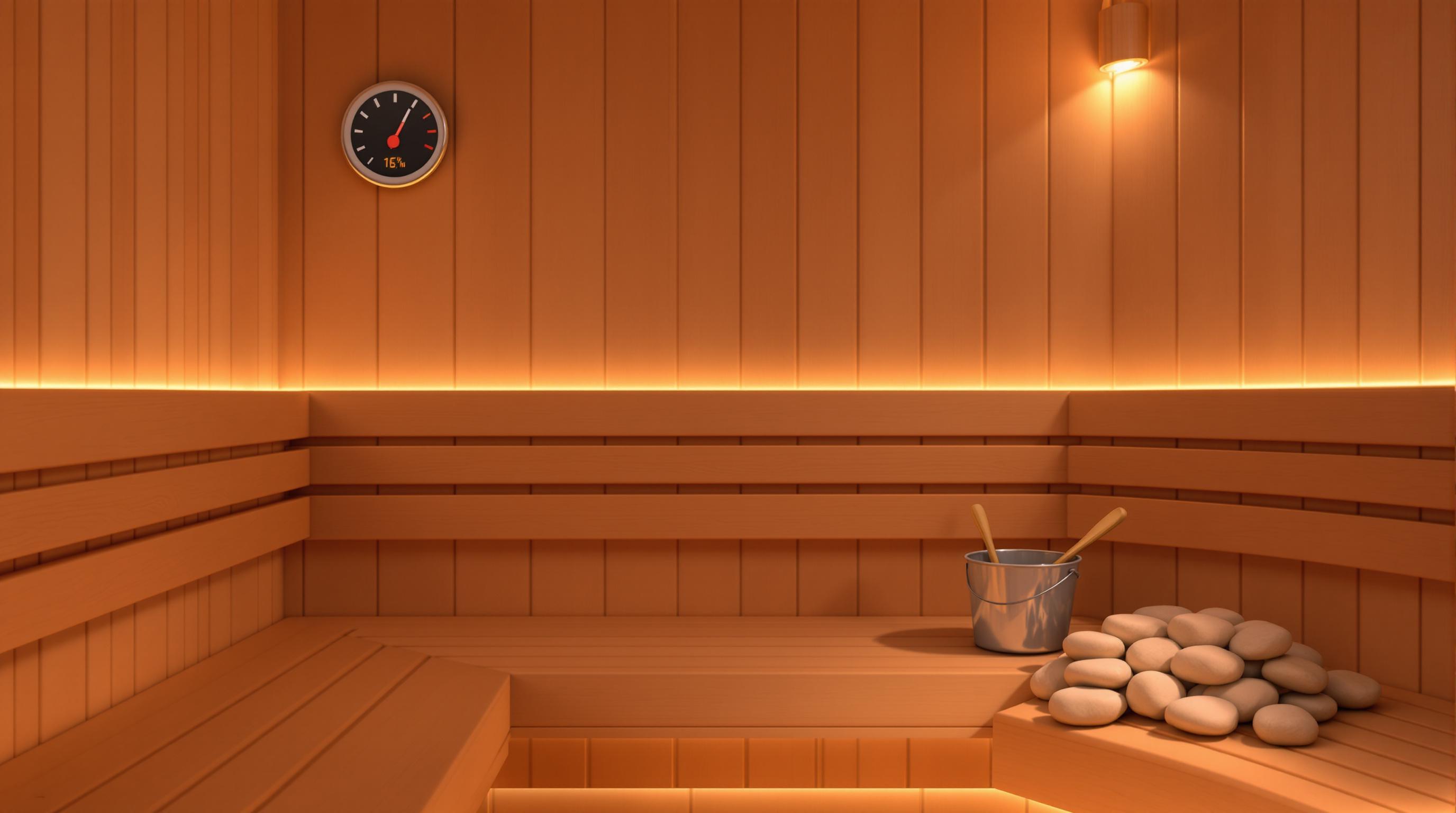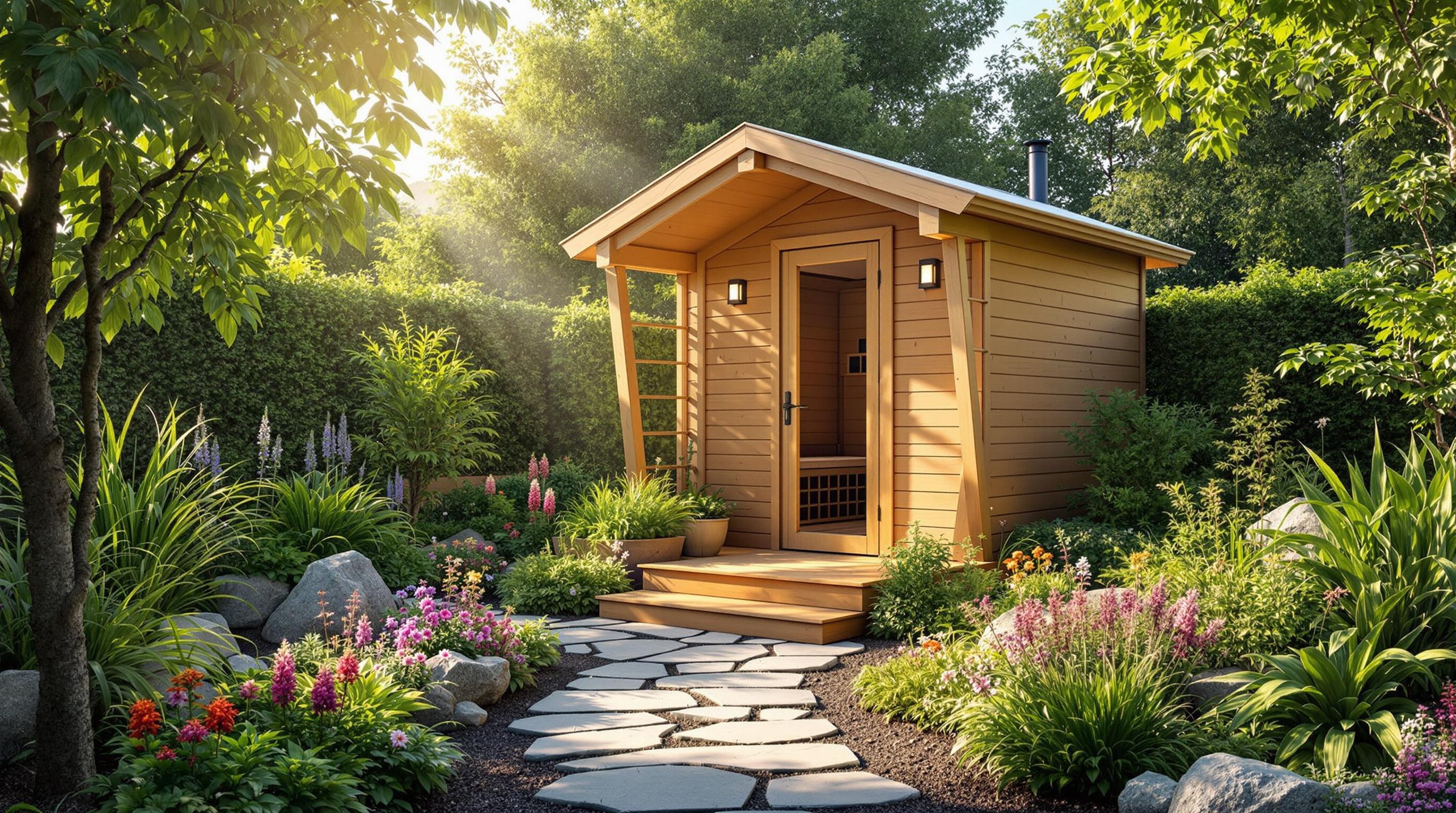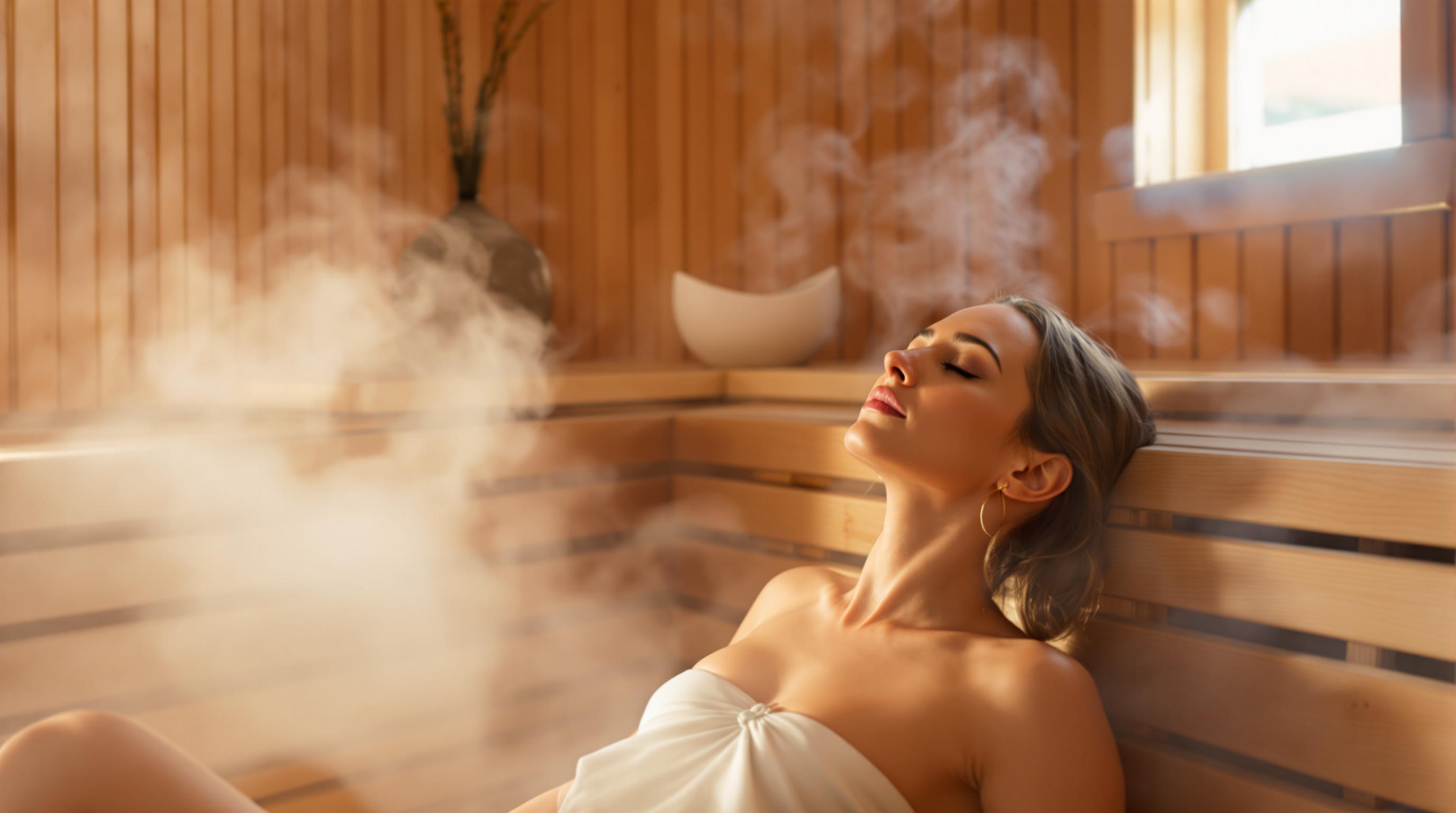Want to relax deeply while improving your mental and physical health? Combining Progressive Muscle Relaxation (PMR) with sauna sessions can help you release tension, reduce stress, and boost recovery. Here's how:
- What is PMR? A technique where you tense and release muscle groups to alleviate stress.
- Why saunas? Heat improves circulation, eases muscle tension, and creates a calming environment.
- How to do it? Follow 5 simple steps: breathing, tensing muscles from toes to head, focusing on core and upper body, releasing neck and face tension, and ending with full relaxation.
Quick Tips:
- Use a sauna 2-3 times a week for 15-20 minutes.
- Stay hydrated before and after sessions.
- Choose the right sauna type: traditional for high heat, infrared for gentle warmth, or steam for added moisture.
| Sauna Type | Best For |
|---|---|
| Traditional | Intense heat, deep relaxation |
| Infrared | Gentle heat, longer sessions |
| Steam | Moist heat, supports breathing |
Pro Tip: Pair PMR with meditation or aromatherapy for an even more calming experience. Start slow and listen to your body for the best results.
Getting Ready for PMR in the Sauna
Choosing the Right Sauna Temperature
Finding the right temperature is key to making your PMR session effective and safe. Start with a lower setting, especially if you're new to saunas, and adjust gradually. If you feel lightheaded or notice excessive sweating, lower the temperature immediately.
| Temperature Range | Best For |
|---|---|
| 150°F (65°C) | Beginners |
| 175°F (80°C) | Intermediate users |
| 200°F (90°C) | Experienced users (maximum recommended) |
Staying Hydrated and Preparing Beforehand
Hydration is essential before stepping into the sauna. Aim to drink 8-12 ounces of water about 30 minutes before your session [1]. Keep a water bottle within reach during your time in the sauna to stay hydrated without interrupting your relaxation [1].
Taking a few minutes to prepare ensures your body is ready to fully benefit from the deep relaxation PMR provides.
What to Wear and How to Sit
For the best results, wear as little as possible - minimal clothing or just a towel works well. This allows heat to distribute evenly and helps you relax [2]. Sit comfortably with your back against the sauna wall, keeping your spine straight yet relaxed. Rest your hands in your lap, close your eyes, and try to block out distractions [2].
Use a towel on the bench to sit on, and keep another handy for wiping away sweat. Choose a spot away from direct heat sources for a more balanced experience.
Once you're set up, you're ready to dive into the step-by-step process of PMR in the sauna.
5 Steps to Relax Your Muscles in the Sauna
Step 1: Start with Breathing and Awareness
Kick things off with deep belly breathing. Inhale through your nose, letting your stomach expand, and exhale slowly through your mouth. While you do this, mentally scan your body from your toes to your head, noting any tight areas you want to focus on during your sauna session [1].
Step 2: Work Through Your Body
Start with the lower part of your body. Curl your toes, flex your calves, and tighten your thighs and glutes for about 5 seconds before releasing. Move up to your core by tensing your abs and chest. Then, clench your fists and flex your arms. Finally, roll your shoulders, gently tilt your head, and scrunch your face for a few seconds before letting everything relax.
Step 3: Focus on the Core and Upper Body
Take advantage of the sauna's heat to help your muscles loosen up. Tighten your abs for 5 seconds, then release as you exhale slowly. Pull your shoulders back slightly during a deep breath, then let them drop as you breathe out. Clench your fists and flex your biceps for a few seconds, then relax.
Step 4: Ease Tension in the Neck, Face, and Head
Let the heat help you release tension in your upper body. Roll your shoulders both forward and backward, then gently tilt your head from side to side. Scrunch your face for a few seconds, then relax those muscles. Finish by tensing and releasing your scalp gently.
Step 5: Relax Fully
Focus on your breathing and the warmth around you, imagining any tension leaving your body with each exhale. Picture calming scenes or try "color breathing" - breathe in a soothing color like blue and exhale stress as a dull gray [3]. Once you've gone through these steps, you can deepen your relaxation by trying other techniques or taking care of your body after the session.
Tips for Getting the Most Out of PMR in Saunas
How Often and How Long to Practice
Start with sessions lasting 5-10 minutes and slowly work up to 15-20 minutes. The Finnish method encourages listening to your body rather than sticking to a strict timer. Regular sauna use - around 2-3 times per week - can be a great way to incorporate PMR into your routine. Once you're comfortable, you can explore adding other relaxation techniques to your practice.
Pairing PMR with Other Relaxation Methods
Using meditation or aromatherapy alongside PMR can make your sauna sessions even more relaxing. For example, try the 4-7-8 breathing technique: breathe in for 4 counts, hold for 7, and exhale for 8. This works well with PMR's focus on releasing tension.
"Combining meditation with an infrared sauna session can help amplify the relaxation and rejuvenation effects." - Clean Slate Author
To enhance the experience, use sauna-safe essential oils like lavender or chamomile. Just make sure to dilute them properly for safety.
Caring for Yourself After the Sauna
After your session, take time to cool down gradually and rehydrate with water or drinks containing electrolytes. Gentle stretches can help maintain flexibility, and eating water-rich foods like fruits and vegetables can support hydration. This mix of cooling, hydration, and light movement ensures you recover well and get the most from your PMR practice.
sbb-itb-3953eb0
Choosing a Home Sauna for PMR
Why a Home Sauna Works Well for PMR
A home sauna makes practicing PMR (Progressive Muscle Relaxation) easier and more private. It lets you tailor the environment to your liking and stick to a regular relaxation schedule. Different sauna types cater to specific needs:
- Traditional saunas: Deliver high heat, ideal for loosening tight muscles.
- Infrared saunas: Provide gentler heat, making them suitable for extended sessions and deeper tissue relaxation.
- Steam saunas: Add moisture to the air, which can complement breathing exercises.
| Sauna Type | Ideal For PMR Practice |
|---|---|
| Traditional | Intense heat, deep muscle relaxation |
| Infrared | Mild heat, longer sessions, deeper tissue focus |
| Steam | Moist heat, supports breathing exercises |
The cost of home saunas varies depending on the type and features. When deciding on a sauna, consider these factors:
- Space: Make sure to measure your available area carefully. Decide if you want an indoor or outdoor model.
- Installation: Some saunas may require electrical work or professional setup.
- Usage: Think about how often you'll use it and whether it's for solo use or multiple people.
Find the Perfect Sauna for Your Needs
Check out Find the Home Sauna of Your Dreams to explore a variety of sauna options. Whether you're drawn to traditional, infrared, or steam saunas, the site provides detailed insights on features, specs, and installation tips to help you choose the right one.
A well-chosen sauna can help you build a consistent PMR routine, boosting relaxation and your overall sense of well-being.
Guided Sauna Relaxation Practice - 15 Minute Relaxing Guided Meditation
Conclusion: Relaxing Your Body and Mind in Saunas
Pairing Progressive Muscle Relaxation (PMR) with sauna sessions can be a game-changer for relaxation and stress relief. Studies indicate that using a sauna regularly - about 4 to 7 times per week - can lead to notable health benefits, including a 40% reduction in overall mortality from various diseases.
| Benefit Category | Impact of PMR + Sauna Use |
|---|---|
| Physical Health | Better heart health, reduced inflammation, improved muscle recovery |
| Mental Wellness | Lower stress, improved mood, reduced anxiety |
| Recovery | Faster muscle repair, improved circulation, less chronic pain |
Research highlights how sauna use improves blood vessel function and reduces inflammation. Adding PMR to the mix enhances these effects by focusing on deliberate muscle relaxation and tension release.
"I have found that 15 minutes in a steam sauna 3 or 4 times a week helps with relaxation and improves my overall sense of wellbeing."
Creating a dedicated space for your routine can make all the difference. Whether you prefer a traditional, infrared, or steam sauna, having one at home allows you to control the environment, temperature, and session length, making it easier to stick to your PMR practice.
Take it slow when starting PMR in a sauna. Begin with shorter sessions and pay attention to how your body responds. This combination of heat therapy and PMR can provide both immediate relaxation and long-term health benefits.
"Regular sauna use may actually offer some impressive health benefits."
FAQs
What is the sequence for progressive relaxation techniques?
Progressive Muscle Relaxation (PMR) in a sauna involves working through your body from the bottom up. Start with your toes, then move to your calves and thighs, tensing each muscle group for about 5-7 seconds before releasing. Shift your attention to your core, focusing on your abdominal muscles and glutes. From there, work on your hands, arms, and shoulders. Finally, finish with your neck, face, and scalp.
| Body Area | Focus Points |
|---|---|
| Lower Body | Toes, calves, knees, thighs |
| Core | Abdominal muscles, glutes |
| Upper Body | Hands, arms, shoulders |
| Head Area | Neck, face, scalp |
Infrared saunas can make PMR even more effective by helping your muscles relax more deeply. Stay in a comfortable position and practice deep, steady breathing as you go through each step.


